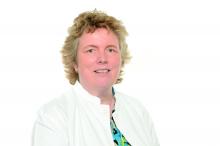The findings were reported at the 2020 San Antonio Breast Cancer Symposium.
“In early luminal breast cancer, optimal patient selection for omission of adjuvant chemotherapy, particularly in patients with one to three involved lymph nodes, is still unclear,” noted principal investigator Nadia Harbeck, MD, PhD, of the University of Munich.
Successive trials have used nodal status, genomic risk scores, and response to preoperative therapy to home in on subsets of women for whom this practice is safe.
The ADAPT HR+/HER2– trial is a phase 3 trial that enrolled 5,625 patients with luminal (hormone receptor–positive, HER2-negative) early breast cancer who were candidates for adjuvant chemotherapy based on conventional criteria.
The trial combined a static biomarker – Oncotype Dx recurrence score (RS) in the baseline core biopsy – and a dynamic biomarker – Ki-67 response to a 3-week course of preoperative endocrine therapy – to personalize adjuvant therapy.
At SABCS 2020, Dr. Harbeck reported results for 2,290 patients having zero to three involved lymph nodes: 868 patients with RS 0-11 and 1,422 patients with RS 12-25 who had a response to brief preoperative endocrine therapy (a Ki-67 fraction ≤10% at surgery). All were treated with endocrine therapy alone as adjuvant therapy.
Similar outcomes
The median follow-up was 60 months. The 5-year rate of invasive disease–free survival was 93.9% for the group with RS 0-11 and 92.6% for the group with RS 12-25 and a response to the preoperative endocrine therapy.
The study met its primary endpoint, as the lower limit of the 95% confidence interval for the difference between groups of –3.3% fell just within the predefined margin of –3.3% or less for noninferiority (P = .05).
The groups also had similarly “excellent” distant disease–free survival (96.3% for RS 0-11 and 95.6% for RS 12-25; P = .247) and overall survival (98.0% for RS 0-11 and 97.3% for RS 12-25; P = .160), Dr. Harbeck reported.
The similar distant disease–free survival was consistent regardless of whether women were younger or older than 50 years and regardless of whether women had involved nodes or not.
In multivariate analysis, women had greater risk of distant disease–free survival events if they had three positive lymph nodes versus zero to two (hazard ratio, 3.40) or a pathologic T stage of 2-4 versus 0-1 (HR, 2.24), whereas risk fell with increasing baseline progesterone receptor expression (HR, 0.92).
“Neither patient age nor study arm were prognostic factors for patient outcome,” Dr. Harbeck noted.
In stratified analysis, the negative impact of having three positive nodes was seen only in the group with RS 12-25 and response to preoperative endocrine therapy, suggesting this subgroup may not be good candidates for omission of chemotherapy, she said.

